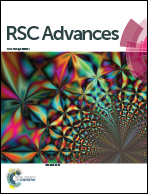Photoluminescent graphene quantum dots for in vitro and in vivo bioimaging using long wavelength emission†
Abstract
Graphene quantum dots (GQDs), due to their ultrasmall size, excellent optical properties, chemical stability, biocompatibility, anti-photobleaching as well as low toxicity, have been widely used as fluorescent bio-probes. In this study, we used the top-down “nano-cutting” route to prepare fluorescent GQDs. The as-prepared GQDs possessed ca. 4 nm diameter with 0.218 nm crystal lattice constant, and they had outstanding solubility as many oxygen and nitrogen based groups were present on them. The GQDs were exploited in bioimaging in vitro and in vivo. Using rat Schwann cells as the model system, the time-dependent cellular uptake of the GQDs was tested by a fluorescence activated cell sorter (FACS) and confocal laser scanning microscope (CLSM), and it reached the saturation point after 24 h. Benefiting from the excitation-dependent PL of the GQDs, multi-color cell labeling was achieved, and the GQDs were proved to be mainly distributed in the cytoplasm and lysosomes. Furthermore, using long wavelength emission (620 nm), in vivo imaging was realized in nude mice.


 Please wait while we load your content...
Please wait while we load your content...